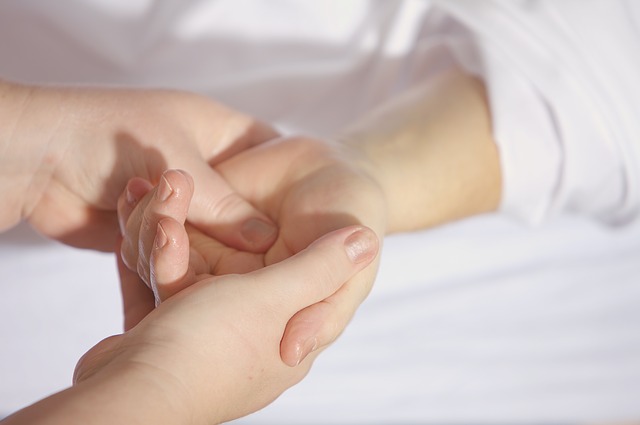Blog
Stress Free Gardening
Gardening is supposed to soothe the body, mind, and soul. Of this triad, one is more vulnerable to becoming strained and that is the body: the lifting, twisting, pulling, and sweating involved with a day in the garden can leave a spine imbalanced. The last thing you want to feel while trying to relax and reap the benefit of your garden is a twinge in the lower back or a muscle spasm in the shoulder region. Follow these tips to keep gardening stress-free for the body:
- Warm-up: you may think, really? For gardening? Yes, I am serious: limber up before you garden with a few simple stretches to prevent injury from occurring to overly tight muscles.
- Kneel > bend: many quick tasks in the garden could be done by quickly bending over and pulling. This is often how people, “throw out” their backs.
- Keep your tools and your task in front of you. This helps to avoid the kind of twisting that damages the back.
- Lift the way your mama taught you: that is, with the legs instead of your back.
- Rest: take breaks, preferably before you feel overworked. Find some shade, have a glass of water or two, and admire your work. Then get back to it.
Finally, stay well adjusted: chiropractic adjustments make sure that your spine is aligned and your nervous system is working properly. It’s good for the mind, soul, and body! To make sure your body is optimized for your gardening routine, give our office a call.
Vacation For Health
The summer of 2023 is entering its final chapter and there are school bells ringing in the distance. What better time to take a vacation? Seeking adventure in remote mountains, serenity on tropical beaches, and fine dining in busy cities is what we work so hard for during the year. Often, these journeys require time spent in the cramped confines of an airplane, which can be torture for ailing spines. Airplane seats are rarely designed ergonomically; in fact, we are lucky if they are even designed for comfort! Checking in with a chiropractor before your flight is a good idea, but if you are taking off tomorrow, keep these tips in mind:
- Support your back during the flight: Bring an inflatable pillow, or use the one that is provided on the plane for your head and use it to support the curve in your lower back.
- Posture, posture, posture: just be aware. Long hours in a cramped space often encourage us to tighten, and you will feel it in the muscles of the neck, shoulders and lower back. Keep your posture upright and try to shake out your shoulders every once in a while.
- Move around: break the monotony and release tension from your back by standing up. It’s everyone’s right on the plane, as long as the seat belt sign is off. Don’t be afraid to look goofy, it feels really good to walk a few laps up and down the aisles.
- Stretch: While you’re standing up, you might as well stretch! Anything you can do to lengthen the muscles and keep them limber against t
- Utilize heat and ice: heat stretches the tissues and ice will prevent swelling.
As we put our bodies through so much just to get these few days of respite every year, it would be a shame to spend these weeks in pain. Call your chiropractor and see what we can do to keep your flight comfortable and see you to your destination and back free of pain.
Elongating the Spine
It may sound like the outcome of a medieval torture tool, but we promise it is not! At our office, we focus on spinal elongation to combat the effects of spinal degeneration. As we grow older, the concepts of posture, exercise, and nutrition become as important as they are easy to ignore. Days turning into months of hard work in the office accelerate the natural process of human body degradation. In short, it is something we all share, the reality that our bodies degrade over time. However, it is within your power to limit how much your lifestyle contributes to this degradation.
Spinal degeneration is often accelerated by a myriad of compressive forces: whether it is caused by acute injury, a condition like scoliosis, or poor posture, these antagonists synergize in their effort to create pain, nerve dysfunction, and changes in the natural curvature of the human spine. As compression effectively warps the spine, pain conditions begin to manifest with symptoms including:
- Pain and stiffness
- Numbness in the extremities
- Loss of coordination
- Sciatica
So what are ways of preventing this? Regular exercise, maintaining a healthy weight with diet, and good posture. These three things, as with so many conditions, make up the base of what we can do with our everyday lifestyle to fight spinal compression. At our office, we help by pinpointing where the problem is happening and targeting our treatments for the individual.
- Decompression therapy: focuses on creating negative intradiscal pressure to allow for retraction of bulging disc material.
- Stretching: targeting specific muscle groups in the back to help elongate the spine.
- We help you learn about the condition and institute lifestyle changes that will reduce its severity.
Elongation of the spine is a relatively simple concept as it relates to your health. We use noninvasive methods to get to the root of the problem. For people attempting to improve their suffering from conditions brought on by spinal compression, we are your ally and greatest fan. Tap into our wealth of resources today by calling our office and scheduling an appointment today.
Nutrition for Joint Health
When it comes to strengthening the spine, food is one of your most formidable allies. Nutrition is fun because you can apply it to whatever scale you are thinking about: as chiropractors, we find nutrition to be particularly helpful in managing the health of joints. Joint aching and pain is generally thought of as a problem for the elderly. Recent studies show that it is much more prolific: arthritis, which is a blanket term to include all kinds of conditions that cause joint pain and stiffness, can affect people of all ages. When eating to keep your joints healthy, the focus should be on consuming anti-inflammatory ingredients which strengthen the bones and boost the immune system. This gives you your best shot at keeping your joints healthy into old age.
Joint-friendly foods: what to eat and what to avoid to harness the power of nutrition for your well-being.
Thumbs-up
- Fish oil, derived from fatty fish. Omega-3 fatty acids are great at fighting inflammation that keeps you stiff and sore.
- Low-fat milk helps to fortify bones that grow brittle with age.
- Olive oil lowers the amount of inflammatory enzymes in the body.
Thumbs-down
- Soda
- Foods high in saturated fat actually conduce inflammation. Sorry, bacon.
- Trans-fat and processed sugars contribute to weight gain and inflammation
Also keep in mind, the more you move the less joints will hurt. This can be rather difficult because pain often prevents you from moving, but give our a call and find out how we can reduce the pain you experience and get you moving again to create a positive feedback loop.
Caloric Balance Helps Balance Your Life
Using nutrition to manage weight is a win-win from a wellness chiropractor’s perspective. We want people to realize that nutrition is the single greatest way to maintain a healthy, “feel-great” weight. When it comes to maintaining a healthy weight, it is important to first establish an appreciation for healthy, wholesome ingredients. Reminding yourself of the Caloric Balance Equation can help anyone balance out their diet quickly and it’s really easy to remember: calories in = calories out.
Caloric balance is the balance between calories you consume and calories you burn through bodily functions and physical activity. This is the key to maintaining a stable weight. When we are gaining weight, whether on purpose or not, our bodies are in caloric excess; we are consuming more calories than we are burning.
So, when you set out to tip the scales in favor of losing weight, it requires a coordinated effort between diet and exercise. If you are looking to make changes in your lifestyle to support shedding a few pounds, you can look to our office for help. We can help correct physical limitations that may be preventing you from being active and give you advice and motivation for eating healthier foods.
Food is about attitude: we often eat a lot of what makes us happy; this does not always translate to healthy decisions. The more we put on the plate, the more we eat, so ask yourself this question next time you write a grocery list: are you feeding yourself the healthiest way possible, or simply the most convenient way possible? We look forward to hearing from and helping you on your new path to health.
Chiropractic for Arthritis
Arthritis is the leading cause of disability in the United States. A term that covers more than 100 types of conditions relating to inflammation of the joints, it is responsible for more lost productivity and income than any other condition befalling a person of comparable age. And arthritis prevalence is on the rise: the CDC projects that by 2040, up to 78 million people will be afflicted by one form of doctor-diagnosed arthritis. Long thought of as a disease of the elderly, arthritis is starting to affect people earlier and more often: 2/3 of diagnosed arthritis cases belong to people between the ages of 18 and 65.
We help sufferers of arthritis come to grips with their condition and demonstrate how a proactive approach to the management of the condition can help you live happily despite the pain:
- Routine spinal adjustments are beneficial because they help inhibit the body’s production of inflammatory cytokines.
- Spinal adjustments also help improve range of motion, helping you to get moving which also improves symptoms.
- Nutrition is a large consideration: ingredients like omega-3 fatty acids help limit the body’s inflammatory response.
- Purposeful exercise and stretching can help improve circulation and limit inflammation.
Whether it is due to deskbound jobs, long hours at the computer and cell phone addiction, it is clear that arthritis has become epidemic. While the statistics don’t look great and there is no clear cure as of yet, chiropractic offers reprieve from the pain and stiffness that comes with the different types of arthritis.
Home is Where the Pool is, Happy 4th!
Getting wet: refreshing for the mind and soul; and, incidentally, extremely beneficial for the spine. With the downward force of gravity suspended, feel your body come alive in the pool. For such a holistic activity, swimming is rarely thought of as a first-choice fitness activity. It usually falls behind biking and running, two activities that are much harder on the joints and muscles than a swim because they involve repetitive impact under the omnipresent gravitational pull.
Here are some ways that being buoyant can benefit your body:
- Soaking: how good does it feel to be in a hot tub? As long as the water is not scalding hot, a good soak gets your blood circulating, encourages muscle relaxation and healing, and is excellent for decreasing inflammation and support of the joints. Another plus is that you can perform this in the comfort of your own bath! For an extra boost to help aches and pains, add some epsom salts.
- Water therapy programs can be specified to the individual. They require stretching and aerobic activity within the (usually warm water) pool, which provides you with all the benefits of soaking plus the benefit of movement to improve flexibility and reduce pain. They can be used to treat back pain of varying degrees.
- Once you are ready to up the ante, swimming is a great way to work out all the muscles of the body because the water provides gentle resistance for your movement but also supports you as you propel yourself through the water.
Swimming is not right for everyone, but it could be right for you: you can never know until you try it. It is important to remember that if you are in pain, No activity should be undertaken unless it is advised by a professional. We offer you the peace of mind that your back has been evaluated to the full extent. Together, we create a plan for rehabilitating and strengthening that addresses your specific condition and gets you back to a state of full health. Call our office to schedule an appointment today.
Text Neck
Talk about a 21st-century condition: the name itself is enough to conjure images of buses full of commuters, head-phones in and heads down, scrolling through their individual news feeds. As a chiropractor, cell phone culture makes me despair. We are seeing the premature onset of spinal conditions linked to young lifestyles that involve too much electronic consumption and not enough physical activity.
Pull your cell phone out of your pocket and have a look: chances are you moved it from pocket to lap, and are looking down at it from above. Very few people heed the conventional wisdom of holding their cell phone at arm’s length and eye level; it’s just not a “cool” look. The problem is about weight: particularly that of the head in relation to the spine. When you hold your phone at hip level and crane down over it, you are magnifying the weight of the head to the spine and creating imbalance at the same time.
Symptoms of text neck:
- Stiffness and soreness in the neck
- Upper back and shoulder pain
- Muscle spasms
- Reduced range of motion in the neck
At our office, we take a proactive approach to treating text neck. Prevention is the name of the game: reducing the amount of time you spend daily looking down at the phone and encouraging you to take breaks if looking at screens for an extended period of time. Any excessive amount of time spent looking down is creating strain on the neck. Rehabilitation is the next logical step: we provide you with spinal adjustments to improve your range of motion and reduce nerve irritation. From here we work on strengthening the core as a support for the upper body and increasing the strength and pliance of muscles in the neck and shoulder through stretching and exercise.
Nutrition for Herniated Discs
A diet for herniated discs is surprisingly similar to a diet for good spinal health, excepting that you probably need an extra boost of anti-inflammatory nutrients to reduce painful inflammation and help you focus on healing. Nutrition for the herniated disc is directly related to the anatomy of the injury: spinal discs are made up of 2 layers.
- Annulus fibrosus: the outer layer, made up of strong collagen fibers.
- Nucleus pulposus: the inner layer, composed of looser fibers that allow for movement and shock absorption.
Because the injury involves the annulus fibrosus becoming strained and splitting, we want to focus on consuming ingredients that help rebuild and fortify the existing cartilage that makes up the structure. Foods to consider include:
- Vitamin C: helps to form collagen, which binds and supports tissue.
- Sulfur-rich foods: supports collagen production, includes foods cruciferous vegetables like cauliflower, broccoli, and Brussels sprouts.
- Glucosamine sulfate: often found in supplement form, this is great for helping the body to form chemicals that help with cartilage repair.
- Omega-3 fatty acids: for their anti-inflammatory properties which help with pain.
As part of a holistic health plan, nutrition is one of the three big elements along with exercise and physical therapy that will help you heal quickly. Your injury could be the wake-up call you need to start eating a more balanced diet to account for the degradation that naturally occurs to our bodies over time. If you are suffering from a herniated disc, it’s time to give our office a call. We specialize in helping you create a plan that incorporates nutrition with chiropractic care and corrective exercise to help you address your pain, get back on your feet and repair the injury fully.
Why Swim?
Just as water can, you can be consumed with weight loss, so too can water be used as a workout medium that is less physically stressful to the body than other sports such as running. As a chiropractor, I wholeheartedly endorse the aerobic, low-stress nature of swimming as a means of losing weight and feeling great. Assuming you are comfortable in the water, here are a few reasons why you might want to consider making swimming your new go-to workout:
- Being buoyant: studies link being in the water with improvement in mood for both men and women. Perhaps this is because as you float, gravity is partially suspended and muscles can relax for a minute.
- Less repetitive trauma: running is the most thought-of aerobic activity, but it comes with one significant detractor, the repetitive shocks to the joints that wear them down over time. This is not the case with swimming.
- Better respiratory function: water is denser than air, meaning that your diaphragm and the accessory muscles must work harder to capture and supply oxygen to your cells. Essentially, you are toning your breathing muscles which will benefit you during your everyday life.
- Whole body workout: water provides a natural resistance that tones the entire body, without you necessarily being aware of it. You may even feel less fatigued, even though an hour of vigorous swimming can burn up to 500 calories.
Swimming is a great thing to add to your life if you have been lacking movement. However, we realize that no exercise can be comfortably attempted if you are restrained by pain. We offer treatment modalities that can treat a body wracked by the stiffness and aching of a sedentary lifestyle and show you why swimming a few times a week may be desirable. Give our office a call to schedule an appointment today.










